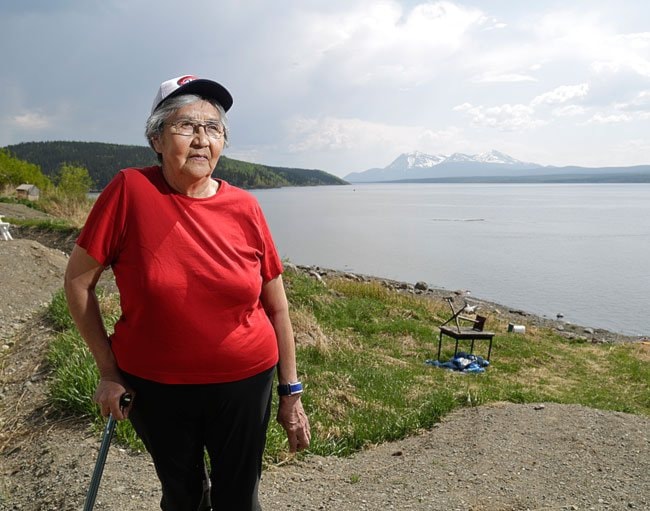First Nations along the Yukon River are preparing for another season without chinook salmon.
This year “is undoubtedly going to be another challenging year for Yukon River fishermen,” said Stephanie Schmidt, a fisheries manager with Alaska Department of Fish and Game, in the Yukon River Drainage Fisheries Association’s first teleconference of the season on Tuesday.
The fish started to trickle into the lower portions of the Yukon River in late May. The first large pulse of chinook migrating upriver is expected in the coming weeks.
Last year saw the most severe fishing restrictions ever for Alaska fishermen. All targeted chinook fishing was completely shut down in an effort to get more salmon to spawning grounds.
As a result, escapement goals were met for only the third time in eight seasons.
On the Yukon side, all but two First Nations voluntarily agreed not to fish at all. The two communities that did fish took fewer than 100 chinook combined, mostly for ceremonial purposes.
This year, the picture is likely to look much the same.
“I just wanted to say thank you for everything everyone’s doing out there,” said Schmidt. “And hopefully the sacrifices that are being made today will help bring the chinook salmon back for future generations.”
Elder Madeleine Jackson from Teslin has been sacrificing a long time. It’s been 17 years since her family set a net in Teslin Lake for salmon, she said.
“I can feel for those old people who never set net for one year,” she said, referring to communities further up the watershed that faced tight restrictions last year.
“But think about us - we sacrificed for 17 years.”
Jackson was born in 1941 on the shores of Teslin Lake, back when what is now the village of Teslin was just a scattering of seasonal family fishing camps for the Tlingit people.
“This was just a summer camp for people, just to come here in June right until August 15 when they go back to their trapline. They get some salmon from here and go back up onto their trapline until June again.
“When I was young there was a lot of salmon. Some of them were about this big,” she said, motioning as high as her shoulder.
A family would take 20 or 30 fish and leave the rest, she said.
“All of the people around here had enough salmon for the winter. They know how much to take, how much to leave and what not to take.”
But about 20 years ago, the salmon started getting smaller, and coming back in smaller numbers.
Teslin is thousands of kilometres from the mouth of the Yukon River, so the effects of overfishing upstream and in the ocean are felt there sooner and more severely.
The Teslin Tlingit Council has led the charge in recent years to have the fishery shut down altogether to allow the salmon stock to regenerate.
Jackson said she wants to see the salmon come back so she can teach her grandchildren to prepare chinook, the way she remembers her mom teaching her as a young girl.
“No matter what kind of mess we made, we still cut it,” she said. “But later on we started getting better. And that’s what I want to teach my grandchildren, too - how to take care of that salmon. They can cut whitefish, trout and everything like that but not salmon. They don’t know how to take care of salmon.
“I’d like to set net, at least teach my grandchildren how to cut the fish and what to prepare and how much to take.”
Last year the First Nation flew salmon in from Atlin, B.C., to have some available for cultural and ceremonial purposes like community potlatches.
“We watch our salmon flying in from Atlin, and that was the saddest thing because we usually take it out of our own net down here,” said Jackson.
In the meantime, researchers are inching closer to a better understanding of what has caused the decline in the chinook run.
The bycatch from the Bering Sea commercial pollack fishery is commonly pointed to as a likely culprit. So is an in-river fishery that in the past has been relatively unbridled and has targeted larger, more productive fish.
But changing environmental conditions both in the ocean and in the river are likely contributors, too, thanks to climate change.
A recent paper published in the Canadian Journal of Fisheries and Aquatic Sciences found a strong link between higher water levels in spawning streams and low productivity of the chinook fry that developed there that season.
The study concluded that this is a plausible contributor to chinook declines throughout the Yukon River basin.
Action is being taken to reduce ocean bycatch, too. Reports of chinook bycatch in Alaska groundfish fisheries dropped to 7,000 last year, down from a high of 54,600 in 2010.
Earlier this year a federal amendment was passed to implement even stricter restrictions. That change won’t come into effect until this fall or next year.
Jackson, for her part, is attending regular international meetings to continue to fight for a co-ordinated push to conserve the salmon.
“I asked the creator to give us strength,” she said. “Give us one mind, one voice, so it can be heard all over the world. So people can start listening to what we’re crying for.”
Contact Jacqueline Ronson at
jronson@yukon-news.com
